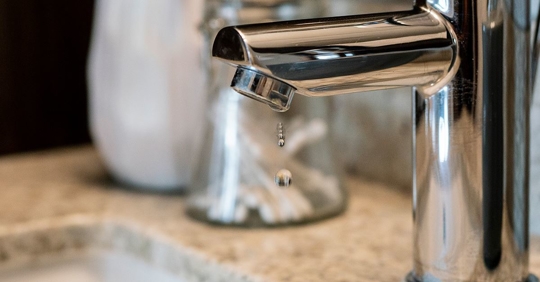Freezing temperatures can do a lot of damage to your pipes if they’re not well-prepped. Water pipes can freeze at temperatures of 32 degrees Fahrenheit or below and are at risk of bursting when they aren’t carefully and professionally thawed. Avoid the risk altogether of burst pipes by following these steps to prevent water pipes from freezing this winter.
Why are Frozen Pipes Dangerous?
The biggest danger of having frozen pipes is the possibility of them bursting. When pipes freeze, ice blockages build up and often do not thaw simultaneously. Because of this, the pressure of thawed, flowing water against these ice blockages can eventually cause the pipes to burst. Not only do burst pipes result in costly repair and replacement damage to your piping and plumbing system, but they can also result in:
- Flooding
- Contaminated plumbing water
- Structural damage
- Mold and mildew growth
- HVAC system damage
Additionally, leaving frozen pipes to thaw naturally not only risks leaving you without running water, but it also may result in uneven thawing, which can also result in burst pipes. Always have a professional deal with your frozen pipes.
How to Prepare Pipes for Freezing Weather
Interior Preparation
- Insulate your pipes. One of the best ways to keep your pipes from freezing is by insulating them with foam, wrap, heat tape, or heat cables. These forms of insulation are all easy to install and will help keep the pipes warm and protected against temperature drops. Just make sure that when installing any type of insulation, especially electrically-powered, you carefully follow the directions. Layering or incorrectly installing insulation can result in overheating.
- Weatherproof your home. Air leaks are a common issue in most homes and can even account for as much as 40% of the energy used to heat and cool your home. Sealing cracks or holes around your home—especially around windows and doors—will help keep the warm air inside and cold drafts away from your pipes.
- Maintain a consistent thermostat temperature. Keeping your thermostat at a consistent temperature above 55 degrees Fahrenheit during the day and night will help prevent ice buildup on or inside your water pipes during cold fronts. Fewer adjustments to your thermostat will also help prevent your heater from being overworked. Having a reliable heating system is vital to preventing pipes from freezing.
- Service your heater. Without regular maintenance, it’s difficult to know whether your heating system will be reliable throughout the winter season. And without a reliable heater, your pipes are at high risk of bursting. Scheduling a tune-up will ensure that your system is working efficiently and safely for the upcoming season.
- Open doors and cabinets closing off pipes. Most water pipes in your home are located in unheated areas closed off by doors and cabinets. It’s a good idea to open up these areas when freezing temps are in the forecast. This will allow for heated air to travel into and circulate through these spaces more easily, giving your pipes the boost of warmth they need on colder days.
- Add wall insulation to unheated areas. The best long-term solution for preventing frozen pipes is by adding wall insulation to unheated areas of your home. This often includes your attic, garage, crawl space, or basement. Even if water pipes are not directly located in one of these spaces, a better-insulated home can make a huge difference in temperature overall.
Exterior Preparation
- Disconnect hoses. Any small amount of water in your exterior hoses and drains can freeze and potentially burst your connected water lines. Fully remove your hoses and store them away for winter to prevent any ice blockages.
- Drain and shut off your outdoor faucets. Standing water inside your outdoor faucet can freeze up and crack either the exterior or interior valve, and potentially burst connected water lines. Draining and shutting them off releases pressure and allows water to safely drip out.
- Winterize your irrigation system. Standing water inside your irrigation system will freeze and create ice blockages that pose another risk to your main water line. Make sure to have your irrigation system professionally winterized.
Related Content: Automatic Water Shut-Off Valves: What They Are and How They Work
Thawing Frozen Pipes
Frozen pipes are difficult and dangerous to thaw on your own. If you notice one or more frozen pipes in your home, immediately call a plumbing professional for pipe thawing services.
While waiting for service, you can follow these general steps to prevent any further freezing or potential burst pipes.
- Keep your faucets open. If any ice begins to thaw, you’ll want to make sure it has space to drain out rather than build up any additional pressure.
- Identify other frozen pipes. This will help your plumber strategize which pipes require more immediate attention if they’re at risk of bursting.
- Turn up the heat. The key to preventing burst pipes is slow and careful thawing. Increasing the temperature in your home will help slowly warm your pipes.
- Open doors and cabinets. As suggested in our preventive tips, opening your doors and cabinets that close off your frozen pipes will help any heated air enter these spaces.
Pipes Need Thawing? Call Your Local Plumbers in Mission, Kansas[OUW6]
Attempting to thaw frozen pipes on your own can lead to burst pipes or further damage to your plumbing system. Rely instead on the certified professional plumbers at Mission Plumbing Heating & Cooling to handle it. Call us at 913-347-5425[OUW7] , or request your service online.

